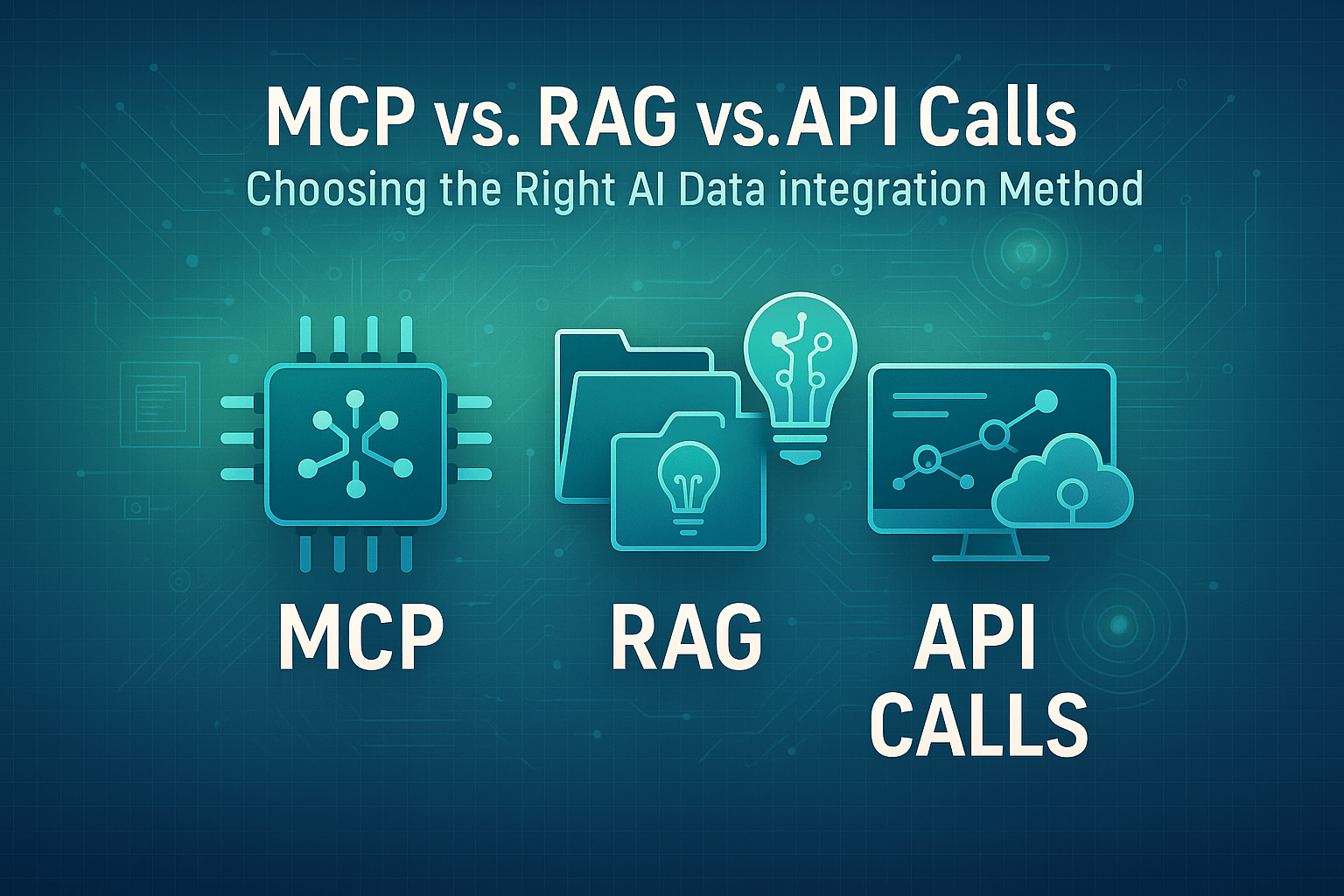
Table of Contents
The Evolving Landscape of AI Data Integration
The potential of generative AI is changing the way organizations interact with data. Large Language Models (LLM) are no longer operating on static training datasets but are being propelled by connections to dynamically, real-time, contextual data. However, connecting LLMs to up to date data isn’t as simple as it sounds. There are three methodologies to accomplish the connection of LLMs with up-to-date data: API calls, Retrieval Augmented Generation (RAG), and Model Context Protocol (MCP).
Each method provides unique advantages, caveats, and scenarios for optimal use. This blog will clarify the key differences between MCP vs RAG vs API Calls, explain how each methodology works, provide comparisons of benefits, and assist you in deciding the right data integration method for your use case.
This article will be useful for anyone developing intelligent systems or setting up a context-aware AI ecosystem.
The Three Main Paths to Connecting Your LLM to Data
Modern LLM powered systems need to connect from a static model to data that is real-world, dynamic, and continuous. Here is how it can be achieved:
Method 1: The Classic Approach Direct API Calls
How It Works: This method uses standard REST or GraphQL API calls to reach out to external services. The data will be fetched at runtime, and either added as part of the context provided to the LLM via prompt engineering or used as context for LLM prompted generation.
Pros:
- Simple and well understood.
- Can work with any data source with an API.
- Easy to deploy for simple calls like lookups or updates.
Cons:
- No memory or shared context between exchanges.
- Must manage your formatting and parsing.
- Can lead to large prompts or repetitive calls.
- Poor scalability for complex workflows or multi turn conversations.
Method 2: The Popular Standard Retrieval Augmented Generation (RAG)
How It Works: RAG adds a retrieval layer in the middle of your model and your structured or unstructured data. Relevant documents or data chunks are embedded, indexed, and retrieved in real-time before being handed over to the LLM.
Pros:
- Allows LLMs to access vast unstructured information.
- Minimizes hallucination by grounding it in your data.
- Good scaling for use cases like a knowledge base or documentation search.
Cons:
- Retrieval is dependent on embedding models and vector search configurations.
- Not always possible to work with structured or dynamic data.
- Difficult to manage real-time data updates that require indexing without having to re-index frequently.
- No native support to activate actions, triggers, or workflows using a retrieval method.
Method 3: The New Contender Model Context Protocol (MCP)
How It Works: MCP is a new protocol defined to support intelligent agents making requests to various tools, systems, and data sources in a contextually aware, standard way. MCP servers are async interfaces, acting as intermediaries orchestrating user and third-party system context, permissions, and state in the active session.
Pros:
- Consistent context management across tools and interactions
- Great for complex orchestration, multi-agent workflows
- Offers native support for secure credentials, authentication, and actions
- Ability to connect structured, semi-structured, and unstructured data
Cons:
- Still developing; smaller ecosystem than traditional APIs
- Needs more setup on initial implementation
- Developers will have to adopt MCP compatible servers or SDKs.
Head to Head Comparison: MCP vs RAG vs API Calls
| Feature | API Calls | RAG | MCP |
| Data Format | Structured only | Unstructured | Structured & Unstructured |
| Real-Time | Yes | Partial | Yes |
| Context Persistence | No | Partial | Full |
| Complexity | Low | Medium | Medium-High |
| Action Support | Limited | None | Full |
| Orchestration | Manual | Basic | Advanced |
| Developer Ecosystem | Mature | Growing | Emerging |
While API calls are quick and easy for basic tasks and RAG is most effective when working with documents, MCP is uniquely positioned for creating context-aware, multi-modal AI workflows.
Real-World Use Cases for Each Integration Method
When to Use RAG:
- Your knowledge base is large and primarily unstructured (FAQs, manuals, case studies).
- You want to make fewer hallucinations and be factually correct.
- The use of RAG is perfect for realizing intelligent search engines, chatbots, and documentation assistants.
When to Use MCP:
- You want to have consistent memory across tools, sessions, and users.
- Your AI Agent needs to perform tasks, take actions, or interact with workflows.
- You want to create an enterprise-grade orchestration, multi-agent collaboration, or complex automation.
When to Use API Calls:
- You need real-time data from structured services (weather, currency conversion rates, product inventories, etc.).
- You want a quick integration and fast build without complicated setups.
- You are prototyping, or connecting to legacy systems.
Challenges & Trade-offs to Consider
Every method has trade-offs:
- Latency: RAG and MCP can incur greater processing time than making direct API calls.
- Maintenance: RAG will have ongoing updates to the embeddings and indexes. MCP will involve learning new technologies to put the setup together.
- Security: APIs are at risk without properly managed authorization layers. MCP features permissioning and scoped access.
- Data freshness: RAG uses indexes for read purposes, so real-time data updates might lag unless you plan on updating the index frequently.
Understanding the trade-offs to your use case will be critical for developing robust AI systems.
Decision Framework: Choosing the Right Integration Strategy
To help you select the best approach to your use case, take a moment to consider the following questions:
What kind of data are you working with?
- Structured? Use API or MCP.
- Unstructured? Consider RAG or MCP.
Does your AI have memory and contextual awareness?
- Yes? Go with MCP.
- No? API or RAG may suffice.
Do you have specific workflows or actions in mind?
- Yes? MCP is the clear winner.
How important is it for your system to use the most up to date data?
- High? Use API or MCP.
- Moderate? RAG may work with periodic index refreshes.
What is the technical capability of your team or organization?
- Familiar with traditional dev? API and RAG.
- Ready to explore modern AI orchestration? MCP.
Why NextGenSoft Recommends a Context Aware AI Strategy
At NextGenSoft, we believe the future of intelligent systems sits on the back of context-aware AI infrastructure. While we all benefit from early LLM applications using APIs and RAG methods, MCP opens the door to a new world of orchestration, flexibility, and dynamic memory across workflows.
We specialize in helping businesses:
- Create AI agents that do not forget, enable task coordination.
- Link internal systems using structured MCP procedures.
- Run RAG and APIs when needed, enabling your hybrid AI strategy.
We have seen how well MCP reduces time to value, especially in more complex ecosystems like finance, healthcare, logistics, and customer service.
The Future: Hybrid Approaches and AI Agent Collaboration
It is valuable to recognize that none of these methodologies is exclusive to others. Many production systems mix methodologies, often revealing themselves as:
- APIs implemented for real-time lookups.
- RAG processes for document enrichment.
- MCP connectors for agent to agent communications and workflow.
Some advanced systems leverage MCP to orchestrate the most opportune time to call an API and to fetch documents with RAG with a goal of supporting persistent user memory across sessions. Hybrid methods will be more commonplace in 2025 and beyond.
AI agents are at the center of this evolution, but imagine if these agents are thinking, remembering, acting, and adapting through protocols such as MCP?
Conclusion: The Right Method Unlocks the Right Results
When you’re deciding between MCP vs RAG vs API calls, keep in mind that you are not just making a technical decision. Rather, you are making a crucial strategy decision that will impact how your AI systems discover data, interact with users, and collaborate.
- For simple tasks, API Calls can be done reliably and easily.
- Unless unstructured knowledge is your truth, RAG is your answer.
- For context rich, collaboration based, task oriented environments, MCP is the way to go.
Knowing these methods and knowing when to use each of them is how you future proof your AI infrastructure.
Ready to build your intelligent, context aware AI stack?
Partner with NextGenSoft to:
- Strategize your AI integration roadmap.
- Implement MCP, RAG, and API based systems.
- Build scalable, secure, and context aware intelligent agents.
- Let us help you unlock the full potential of your AI systems.
Speak with NextGenSoft today and future proof your tech stack for the AI world.
